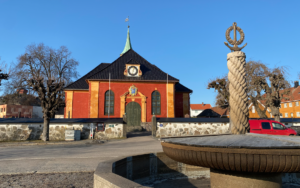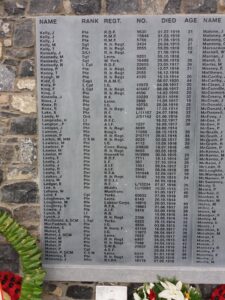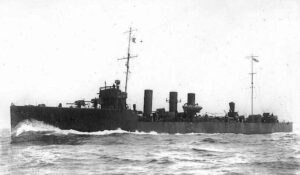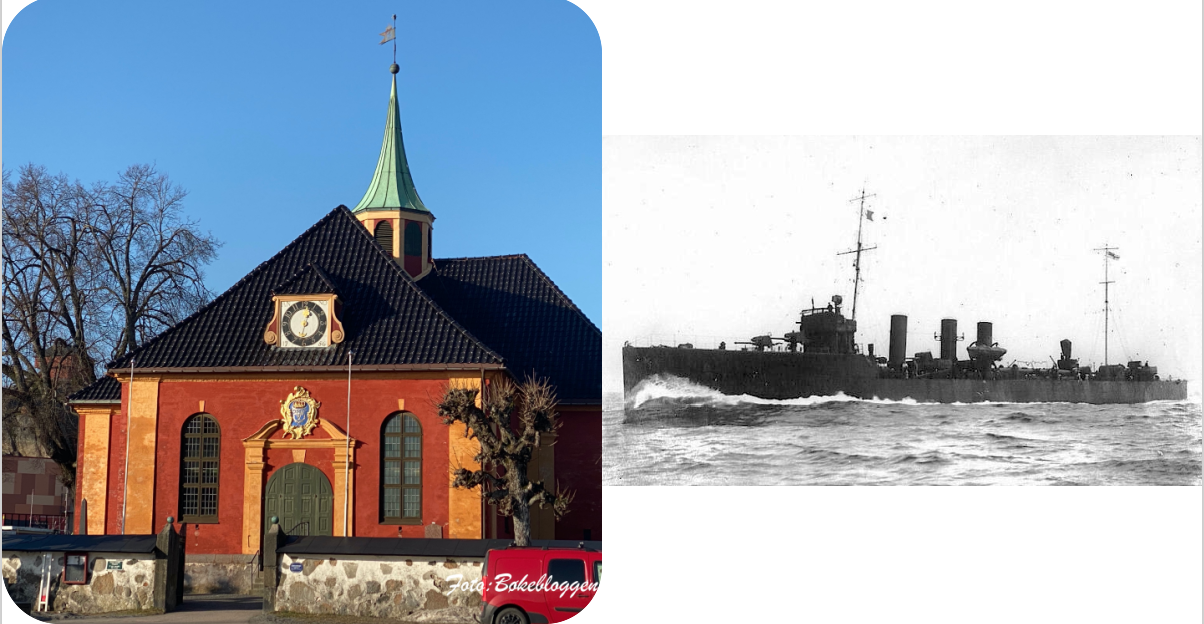It was Elizabeth Korstvedt Nilsson who introduced Bøkebloggen to the war graves. She wrote the following: «In the cemetery in Stavern, there are six sailors from the Battle of Jutland during the First World War, four of them are unknown, but two grave stones have names written on them. Perhaps it is possible to find out something about these sailors as well?»
Thank you very much to Berni Egan, Ireland, for invaluable information.
Thank you very much also to Donal Croghan, Chairman of the Kilkenny Great War Memorial Committee, who gave Bøkebloggen permission to use the image of the Kilkenny World War I Memorial and passed our questions on to Egan.
The war graves at Stavern cemetery are located south of Fredriksvern church, approximately 15 meters from the southernmost entrance to the cemetery.
In June 1916, 17 marines, who had died in the Battle of Jutland during the First World War, were found adrift along the coast of the Larvik district. They were buried in the Stavern cemetery.

Stavern cemetery. Foto:Bøkebloggen
Six of them were from the British Commonwealth. Their graves are marked with individual granite headstones. Two of the fallen are known by name: George John Charles Bucklow (1896–1916) and Nicholas Landy (1890–1916).
A cross with the words «North Sea Battle 3-5 1916. Six brave British sailors rest peacefully here» has also been erected on the field.

Nicholas Landy’s name is included in the Kilkenny World War I Memorial
Photo: Courtesy of The Kilkenny Great War Memorial
11 German fallen from the same naval battle were also buried there. In 1962, the graves were moved to the Alfaset cemetery. At the Stavern cemetery there is a commemorative plaque with the following words in Norwegian and German: «In this place, 11 German soldiers from the First World War were buried, before they were transferred to their final resting place in 1962 at the German soldier’s cemetery Alfaset near Oslo. Stavern municipality is thanked by the Volsbund deutsche Kriegsgräbervürsorge on behalf of the bereaved for the year-long care of the graves.»
The Battle of Jutland was the largest naval battle of the First World War and the only battle between battleships. Over one hundred thousand men and a tonnage of two million gross tons took part in the battle, which was fought on 31 May–1. June 1916 in the North Sea west of Jutland between Great Britain’s Grand Fleet and the Imperial German Navy’s Hochseeflotte.
The Battle of Jutland is one of the most talked about and documented battles in naval history. The discussion between the experts about who actually won the Battle of Jutland has continued up to this day, and will continue. Both the British and the Germans claimed in their war propaganda to be the winners of the battle. Measured in tonnage, the British lost 155,000 of their 1,250,000 grt, and 6,096 of their 60,000 men. The Germans lost 61,000 of their 660,000 BRT, and 2,551 of their 45,000 men. The battle was thus a German material victory.
Strategically, the battle had some significance. The German fleet was unable to break through the British blockade, and with many ships badly damaged, opportunities for offensive operations at sea were limited for the next few years; the German North Sea Fleet did not attempt to make any more similar sailing attempts. Instead, the Germans’ naval strategy henceforth went in favor of submarine warfare, which meant that the British naval force was to some extent split up to be able to act as an escort in the new convoy system. The result of the battle can be said to have been that the British put an end to the Germans’ military operations at sea during the First World War, with the exception of the submarines.
Østlands-Posten stated in its edition of 26 March 2011 that the following Germans had been identified: Captain Lieutenant Karl August Ulrich Walter Berger, Quartermaster Josef Krevert, Chief Machinist Fritz Schimpke and Machinist Arthur Wieland.
Berger had served on board the light cruiser SMS «Wiesbaden», which on 1 June 1916 was sunk by the British battlecruiser HMS «Invincible». 598 crew members perished. The only survivor was chief fireman Hugo Zenne, who was picked up by the Norwegian steamer «Willy» and brought to Tønsberg. The Norwegian authorities wanted to detain him, but was sent home to Germany after a persistent effort by the German naval attaché in Norway, Hans Hilmers.
George John Charles Bucklow was born on 17 January 1896 in the town of Maidstone in the county of Kent, England. The 1901 census listed him as living with his parents George and Elizabeth Rebecca Bucklow at 170 Wheeler Street East in Maidstone.
On 9 October 1911, Bucklow became Boy 2nd Class on the Royal Navy’s training ship HMS «Ganges». A boy aged 15 to 17 was rated as such on entry to a training ship of the Royal Navy. Such entry was conditional on a boy’s adequate physical height, weight, medical fitness, and evidence of being of ‘good character’. The boy’s parents or guardians would sign a declaration that the boy would serve in the navy for a minimum period (usually 12 years).

HMS» Turbulent. Photo: Unknown / Wikimedia Commons
In 1916, Bucklow became an able seaman aboard the Royal Navy’s destroyer HMS «Turbulent». He fell in action when HMS «Turbulent» was sunk by the German battleship SMS «Westfalen» in the early hours of 1 June 1916. Only 13 survived out of a crew of 109, and they were interned as prisoners of war. Bucklow was buried on 26 June.
Nicholas Landy was born on 24 November 1890 in the town of Garryricken, Windgap, in County Kilkenny in Ireland. Ireland was at this time a part of Great Britain. The Irish Free State was established in 1922. His parents were farmer John Landy and Alice, née O’Brien. The 1911 census listed Nicholas Landy’s occupation as farm labourer.
He volunteered for the Royal Navy in Chatham, England, on 7 March 1916.
Landy served as an ordinary seaman on board the Royal Navy’s destroyer HMS «Ettrick» 9 April–2. May.
He was in the barracks «HMS Pembroke I» in the naval base at Chatham 3 May–11. May, pending to be transferred to a new ship.
Landy served as a midshipman aboard the destroyer HMS «Turbulent» from 12 May. He fell in action on 1 June 1916 and was buried on 30 June.
On his tombstone is engraved «Mother’s Only Son». Landy had three sisters: Catherine (1893–), Alice (1895–) and Margaret (1898–).
His name is included in the Kilkenny World War I Memorial in the Kilkenny Peace Park.
Morten Bakkeli




